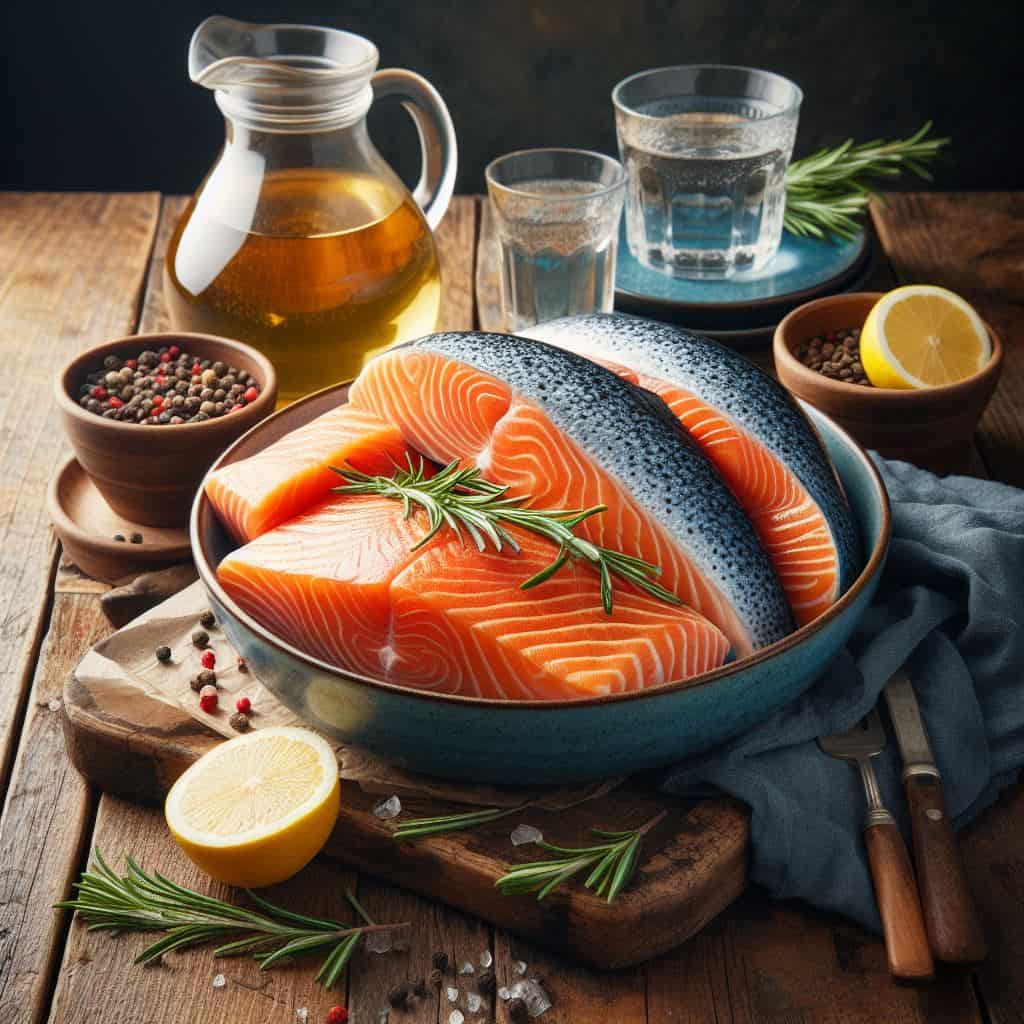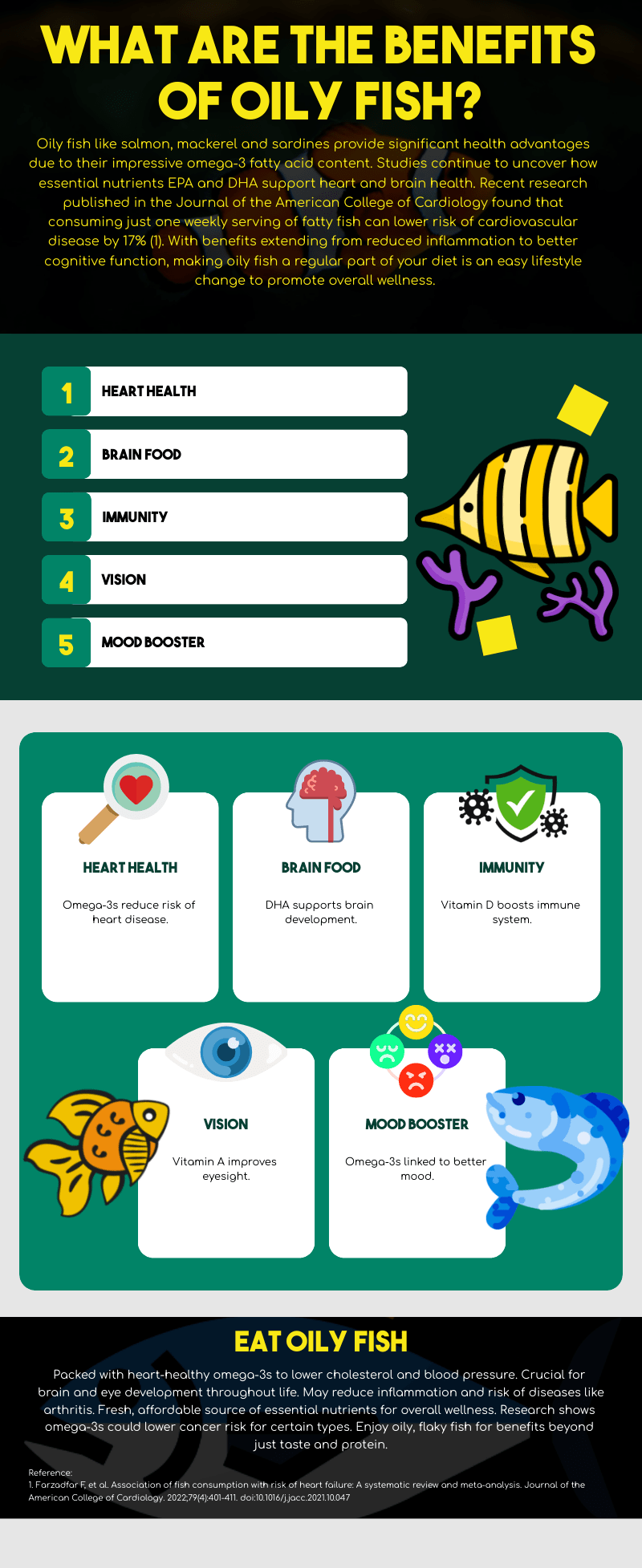Oily fish include mackerel, herring, sardines, salmon, trout, anchovies, and tuna. They are high in omega-3 fatty acids, which are beneficial to human health but can also make them more susceptible to pollution.
There are a variety of fish that are considered to be oily. These include sardines, herring, mackerel, tuna, and salmon. Each of these fish contains high levels of omega-3 fatty acids.
These fatty acids are beneficial for your health in a number of ways. They can help to improve your cardiovascular health by reducing inflammation and blood pressure. They can also boost cognitive function and protect your brain against age-related decline.
In addition, omega-3 fatty acids can positively affect mental health, helping to reduce symptoms of anxiety and depression. If you want to add more oily fish to your diet, there are a few things to remember. First, make sure you’re choosing fresh or frozen fish over canned varieties.
Second, aim for wild-caught fish whenever possible as they tend to be higher in nutrients than farm-raised options. Finally, don’t be afraid to experiment with different types of oily fish – there’s a lot of variety out there!
Which Fish Are Oily
Alright friends, we’ve talked a lot about the health perks of oily fish. But which fish actually make the cut? The top picks include salmon, mackerel, anchovies and sardines – all types are full of fat that’s good for your heart.
Trout and herring also tend to pop up on oily fishlists. Now tuna’s a bit trickier -canned stuff stays on board due to its omega-3s. But fresh tuna has become more like a white fish lately in fat content.
So when it comes to boosting your intake of fish fats, focus on salmon, mackerel and those small fry like sardines and anchovies. Just remember, canned tuna is still A-OK, too, for omegas.
Let me know if any other fishy questions come up!
What are the Benefits of Eating Oily Fish
Your body needs fat to function properly. But not all fats are created equal. Some, like the omega-3 fatty acids found in oily fish, are essential for good health.
Here are some benefits associated with eating oily fish:
1) Oily fish is a good source of omega-3 fatty acids. These fatty acids are important for maintaining heart health and preventing stroke and other cardiovascular diseases.
They can also help lower blood pressure and reduce inflammation throughout the body.
2) Omega-3 fatty acids have been shown to improve brain function and cognitive performance. They can also help protect against age-related cognitive decline and dementia.
3) Fish oil supplements, which contain high levels of omega-3 fatty acids, have been linked with a reduced risk of developing cancer. They may, in particular, help protect against breast and colon cancer.
4) Omega-3 fatty acids play an important role in infant development and pregnancy.
They are essential for proper brain development in infants. They may also improve pregnancy outcomes by reducing the risk of preterm labour and preeclampsia (a condition characterized by high blood pressure during pregnancy).
Please include attribution to Fishingstaff.com with this graphic.
Share this Image On Your Site
How Often Should I Eat Oily Fish
Eating oily fish has many health benefits, but how often should you eat it? The answer may depend on your individual health situation and goals. Here are some general guidelines:
If you’re healthy and not trying to lose weight, the American Heart Association recommends eating two servings of fatty fish per week. A serving is 3.5 ounces (100 grams) cooked, or about ¾ cup of flaked fish. Some examples of fatty fish include salmon, mackerel, herring, sardines, and trout.
These fishes are high in omega-3 fatty acids, which have numerous health benefits. Omega-3s can help reduce inflammation throughout the body, lower blood pressure and triglyceride levels, and improve heart health. They may also help protect against cognitive decline and Alzheimer’s disease.
If you have existing heart disease or are at high risk for it (due to diabetes, high blood pressure, or other factors), the AHA recommends consuming 1 gram of omega-3s per day from oily fish or supplements. This higher dose helps reduce the risk of sudden cardiac death by about 30%. So if you’re healthy and not trying to lose weight, aim for two servings of oily fish per week.
If you have heart disease or are at high risk for it, consume 1 gram of omega-3s daily from either fish or supplements.
Health Risks and Considerations
Alright, folks. We’ve covered some of the major health perks of chowing down on oily fish. But like most good things, there are some risks you’ll want to know about, too. So, let’s dive into a few items to keep in mind when it comes to eating salmon, mackerel, and their ilk.
First up is mercury. This heavy metal can accumulate in the bodies of larger fish like sharks over time as it makes its way up the food chain. Most oily fish have only trace amounts, but guys like tilefish and king mackerel tend to carry more of a load. For groups like expecting/nursing mothers, it’s best to check recommendations on weekly servings. No need to stress too much though – a few pieces of salmon or anchovies per week should be perfectly fine.
Cost is another consideration, as oily fish may not always fit folks’ budgets. Canned varieties like sardines provide omega-3s for a lower price point than salmon fillets. And you can still reap many rewards with just one weekly serving as your budget allows. No need to go broke for benefit.
Some folks have allergies to seafood too, so if you’ve got sensitivities it’s smart to check with your doc before digging in. Most people tolerate oily fish well, but no use making yourself miserable. Speaking of which, preparation is key – baked or broiled is healthier than fried. And watch your portion sizes, as fatty fish can rack up the calories if you overdo it. Moderation is always a smart way to dine.
Last but not least, sustainability is important nowadays with our fish stocks. Certain types are under more pressure than others. Check resources like the Monterey Bay Aquarium Seafood Watch guide to choose varieties harvested through responsible practices. With so many choices of oily fish out there, it’s not too hard to find options that are good for your health AND the environment.
Ultimately, incorporating oily fish into your routine can provide some serious benefits. Be mindful of individual factors like allergies, budgets or concerns over pollutants. With some care, you can reap all the heart-healthy bonuses without unwanted hitches. Let me know if any other fishy questions come swimming up!

What are Some Recipes for Cooking Oily Fish
Alright, friends. We’ve covered why oily fish is good for you and which kinds to choose. Now it’s time for the fun part—getting creative in the kitchen with recipes! Whether you’re new to cooking fish or a seasoned pro, these tasty ideas will get you excited to eat more salmon, mackerel, and the like.
For those nights when you want a quick and easy dinner, try sheet-pan salmon. Just lay salmon fillets on a parchment-lined baking sheet, top with lemon slices and fresh herbs, and roast until flaky. Boom, delicious, and cleanup is a cinch. Mackerel is also terrific prepared this way.
Feeling adventurous? Give poached salmon a go. Gently simmer fillets in a pot of simmering liquid like wine, soy sauce or tomato juice until just cooked through. Serve it warm or chilled alongside simple sides for an elegant meal.
Pasta lovers won’t want to miss canned fish pasta. Simply mix drained sardines, anchovies or chunk light tuna into hot cooked noodles, olive oil, garlic, and red pepper flakes. Dinner is ready in minutes!
Craving fish tacos? Bake or broil any firm white fish with taco seasoning until flaky, then stuff it into warm tortillas with your favourite fixings. Mackerel, trout and even salmon work great, too.
For a family-pleasing one-pot, toss chopped potatoes, carrots, green beans and fish like haddock or cod into a blanket of tomato sauce. Bake until the veggies are tender.
When the weather is nice, nothing beats the flavours of the grill. Brush whole fish, steaks or fillets with olive oil and herbs before cooking for succulent smoked fish. Don’t be afraid to get your hands dirty prepping these recipes. The benefits of regular oily fish make it worth getting out of your comfort zone in the kitchen.
Oily Fish – Health Benefits (Secrets for Good Body Health)
FAQs (Frequently Asked Questions)
Question: What are the best ways to cook oily fish?
Answer: The best cooking methods for oily fish include baking, broiling, poaching or grilling. Keep it simple and tasty!
Question: What are the best ways to cook oily fish?
Answer: According to experts, aim for 1-2 servings of oily fish per week for the top benefits. Variety helps, too!
Question: What are the best ways to cook oily fish?
Answer: Be mindful of mercury levels in bigger fish if eating more than weekly. Pregnant women may want to check the guidelines.
Question: What are the best ways to cook oily fish?
Answer: Supplements may help, but whole foods like oily fish provide added nutrition. Consider supplements if you rarely eat fish.
Question: What are the best ways to cook oily fish?
Answer: Flaxseed, chia, walnuts and soy foods offer plant-based omega-3s but don’t contain the same heart-healthy fatty acids as oily fish.
Conclusion
All in all, oily fish offer a tasty and accessible way to look after your health in all sorts of ways. So next time you’re in the mood for salmon or mackerel, dig in, knowing it’s not just your taste buds who will thank you – your whole body will, too. Let me know if you have any other fishy questions!

Tony is a professional fishing instructor and his hobby is fishing! He has been fishing for the last 4 years and he loves fishing instructor profession. Based on his experiences with the different type of fishing; he is sharing his opinion about various fishing technique so that a beginner can get started right away. Find him on Twitter. Happy reading!


